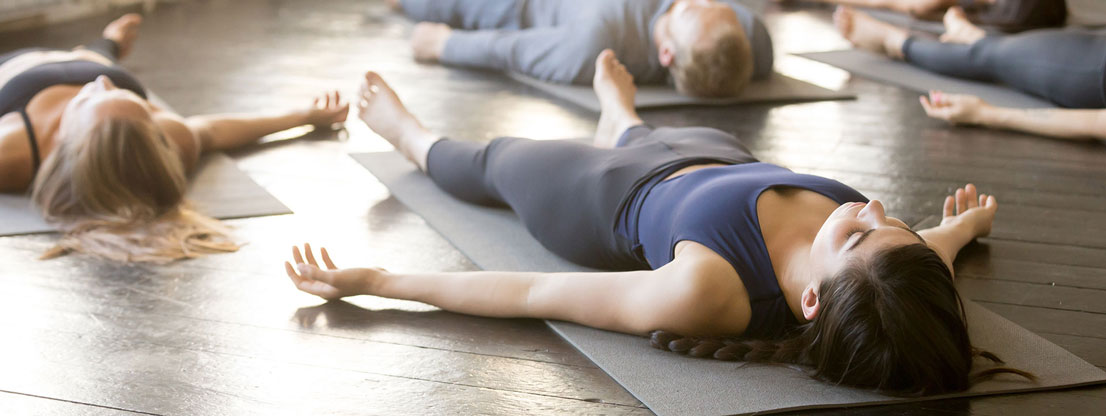What does meditation actually consist of?
Meditation is about taking a break and giving your own experiences, thoughts and feelings space to unfold. In meditative exercises you learn to find peace, to perceive yourself and your needs and to deal with problems successfully and gently. Meditation is an important part of various religions and philosophies of life such as Buddhism, Hinduism or the increasingly emerging mindfulness movement. It is often experienced as a consciousness-expanding and spiritual experience. Modern medicine also makes use of meditation and its effects on people in very different contexts.
With this multitude of different currents and meditation variations, especially beginners quickly lose the overview. But don’t let that stop you. In this text you will find background knowledge and twelve tips for a successful introduction to the world of meditation.
What types of meditation exercises exist?
You can meditate both sitting and moving. Some exercises help you to pay attention to a specific thing and to concentrate on it. In these exercises you focus, which means that you calm down and relax. In insight exercises, you try to fathom your own mind and make yourself aware of emotional and mental processes. Here you can recapitulate experiences from your everyday life and cope better with difficult situations in the future. There are also devotional exercises in which you recite the same words, movements or thoughts over and over again. [1]
12 tips for your successful start in meditation

Tip 1: The right exercise
Every person is different and so you too must find a suitable way that makes it as easy as possible for you to enter the world of meditation. It is best to try out several types of meditation exercises and then choose the one you feel most comfortable with. If you find it difficult to sit still for a period of time, you can combine movement and meditation in one exercise. In yoga, for example, you will find many exercises that combine physical exercise and mindfulness from the outset. If sitting still does not cause you any problems, a collection exercise in which you concentrate on your breathing might be the best way to start. Or you might recite a mantra, or the same words or phrases over and over again to focus your mind on meditation. [2]
Tip 2: An appropriate place to meditate
To be able to concentrate on your meditation practice, you should find a place where you are not easily disturbed. Make sure you find a quiet atmosphere in which you feel comfortable. Warm light, a pleasant temperature, a discreet but cosy interior or even the right meditation music can be important basic requirements for successful meditation.
Tip 3: A comfortable sitting position
When you think of meditators, you are likely to see people sitting in lotus position. In this sitting position the legs are crossed and the feet rest on the thighs of the other leg. However, the lotus position can be extremely uncomfortable, especially for beginners. Choose a comfortable sitting position where you can really relax. Under no circumstances should you feel pain when meditating. Especially for people who cannot do the lotus position, a meditation cushion can help you to sit upright but comfortable and concentrate on your meditation exercises.

Tip 4: Switch off your mobile phone before the exercise
In order to be able to concentrate properly, you should make sure that all electronic equipment that you do not need for your exercise is switched off. A mobile phone in silent mode is also a temptation and distraction that you should avoid. [3]
Tip 5: The proper time to meditate
In order to get into meditation slowly, it is important that you set a time from the beginning four to five times a week where you reliably plan time for your exercises. Because only if you integrate meditation meaningfully into your everyday life, the necessary continuity, which is necessary for meditation, is given. It takes about three months until we have really internalised a new behaviour. Until we become a master in a behaviour, about 10 000 hours of practice. So it is important not to let the meditation slide, but to pay attention to regularity. [4]
Tip 6: Music or silence?
You don’t have to meditate in absolute silence. Especially in the beginning, meditation music or a relaxing background noise can help you to concentrate and engage in an exercise. The right music soothes our mind, but also has a blood pressure-lowering effect on our body, for example. [5] In a guided meditation, you will find in the voice of the narrator a point of reference to hold on to so that your thoughts do not drift away. sonamedic offers you a wide range of mindfulness and relaxation exercises with different focuses. You can also find a large selection of music and guided meditations on YouTube or Spotify to help you get started.
Tip 7: Don’t get carried away
You first have to get used to meditating. In the beginning you should not force yourself to sit still for an hour. Small intervals of ten to twenty minutes are quite sufficient to get you started and prevent frustration. Only when you have slowly familiarised yourself with meditation can you gradually extend the time intervals.
Tip 8: Proper breathing
An important part of successful meditation is correct breathing. Hasty, shallow breaths cause an increased concentration of carbon dioxide in your lungs, as you do not exhale the used air completely during such a breathing pattern. This of course means stress. It is best to try to breathe in and out slowly through your nose. In your mind, you can also count with your breaths. For many people, abdominal or diaphragmatic breathing is the most comfortable. We automatically use this breathing pattern when we are relaxed. To practise abdominal breathing, it is best to lie down and place both hands on your stomach at about navel level. Now breathe in and out deeply, paying attention to the counter-pressure of your hands. This type of breathing has a calming effect on you and helps you to find peace. [6]

Tip 9: Give space to your thoughts
While meditating, whether you like it or not, your thoughts will drift away. Try not to ignore them, accept them and include them in your mediation. You can also focus on a specific topic during an exercise in awareness.
Tip 10: Help with meditation
Especially for beginners it can be very helpful to seek professional help when meditating. An experienced person, who will support you with questions or problems and accompany you during the first weeks, can make the start much easier. The exchange with like-minded people also has a stimulating effect on the meditation process. Maybe it is worthwhile for you to attend an eight-week MBSR course. MBSR stands for Mindfulness-Based Stress Reduction and is a stress reduction programme developed in the 1970s by John Kabat-Zinn, which combines various mindfulness and meditation exercises. Many meditation centres regularly offer MBSR courses. Why don’t you just try it out? [7]
Tip 11: Meditation – not a method for self-optimisation
Many people who start with meditation see it as a tool for self-optimisation. If you consider mediation as self-optimisation, you are only replacing the stress from your everyday life with the stress of achieving quick success through your meditation exercises. Meditation is not a means to become more productive from one day to the next or to get your emotions completely under control. The aim of mediation should be to give you time and relieve pressure. Under no circumstances should you try to force results. [8]
In fact, it is not the result that matters, but the path we take. Through meditation you will not become a completely new person, even after years of meditation. Perhaps only after a year of practice will you achieve smaller successes and you will be able to be more attentive to yourself and your emotions or to recharge your batteries. [9]
Tip 12: Do not get discouraged – meditation can be unpleasant
When you learn to take a step back and listen to yourself, all your problems, worries and needs come rushing at you. Stress, anger, fear and sadness, which you may have suppressed for a long time, come back to you in the relaxation and meditation exercises. This can be a very upsetting and unpleasant process, which has surely made many meditators give up.
You should not make the mistake of confusing the meditation exercise with the result. Meditation can be painful, but you learn not to simply suppress your feelings, but to deal with them. In the long run this is certainly the healthier way. [10]

Easy meditation exercises
Exercise 1: Breathing and body (25 minutes)
Find a quiet place and get yourself into a comfortable sitting position. Pay attention to your breathing, breathe in and out slowly and feel the air filling your lungs. With each breath you can recite words like “on” and “off” to the rhythm of your breath to help you concentrate better.
After five minutes of breathing meditation, focus your attention on your body. Slowly wander with your thoughts from top to bottom. Feel the pressure, the warmth, the draft on your skin. In this way you can slowly relax.
Exercise 2: Walking slowly (10-20 minutes)
Find a place where you can walk a few steps, for example the floor of your flat. Walk slowly from one end of the corridor to the other and back again. You can recite something in the rhythm of the movement, for example by saying “yes” at each step. You should continue this exercise for ten minutes or more. As you walk, you can change your pace from time to time. Go slowly at first, then faster, then slower again, and focus your attention on your steps. [11]

Meditation and science
Until recently, much of the scientific community assumed that we are prisoners of our own genetic make-up with which we are born. For a long time, mind and body were also treated separately. However, new research, particularly in the field of epigenetics, suggests that our environment and also our thoughts and feelings can very well influence our body. [12]
A meta-analysis of several studies from 2014 showed that meditation can mitigate the negative effects of psychological stress and bring about small improvements in depression, anxiety and pain. [13] Another study from the same year showed that epigenetic meditation increases anti-inflammatory processes in the body. You can also influence blood pressure and oxygen uptake through meditation. [14]
Scientific sources
1) Wetzel, Silvia: Meditieren – aber wie? Krisen in der Meditation überwinden. 2018, Seite 15. Online
2) Wetzel, Silvia: Meditieren – aber wie? Krisen in der Meditation überwinden, 2018, Seite 16. Online
3) Banzhaf, Harald / Schmidt, Stefan: Meditieren heilt. Vorbeugen und gesund werden durch Achtsamkeit, 2015, Seite 76. Online
4) Wetzel, Silvia: Meditieren – aber wie? Krisen in der Meditation überwinden, 2015, Seite 17. Online
5) Spitzer, M. / Rath, F./ Groen, G.: Musik und Befindlichkeit. Erste Ergebnisse zum Einsatz einer Klangliege bei depressiven Patienten, Ulm 2015.
6) FOCUS Online: Coach: Üben Sie die Bauchatmung. Datum des Zugriffs: 03.09.2019. Online
7) Wetzel, Silvia: Meditieren – aber wie? Krisen in der Meditation überwinden, 2018: Seite 22f. Online
8) Wetzel, Silvia: Meditieren – aber wie? Krisen in der Meditation überwinden, 2018: Seite 43f. Online
9) Wetzel, Silvia: Meditieren – aber wie? Krisen in der Meditation überwinden, 2018: Seite 19f. Online
10) Wetzel, Silvia: Meditieren – aber wie? Krisen in der Meditation überwinden, 2018: Seite 26f. Online
11) Wetzel, Silvia: Meditieren – aber wie? Krisen in der Meditation überwinden, 2018: Seite 118. Online
12) Banzhaf, Harald / Schmidt, Stefan: Meditieren heilt. Vorbeugen und gesund werden durch Achtsamkeit, 2015, Seite 57. Online




